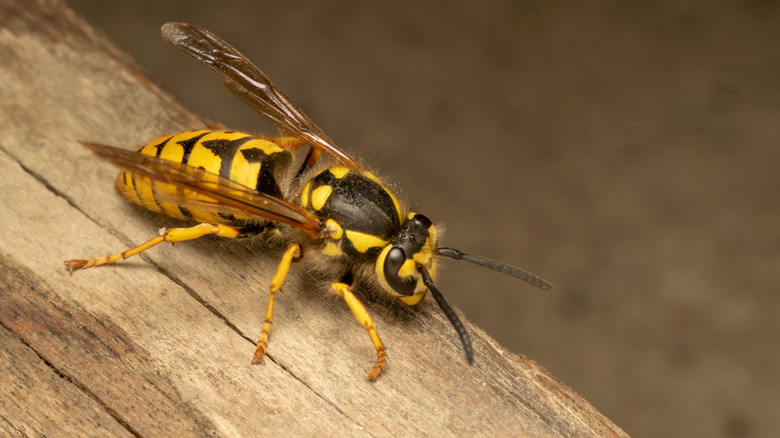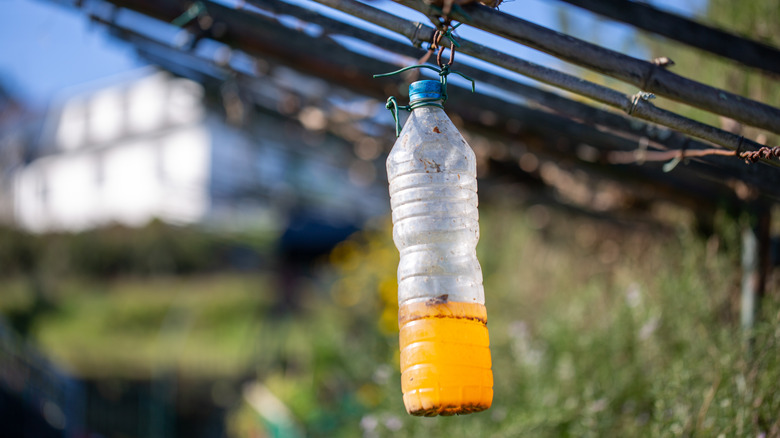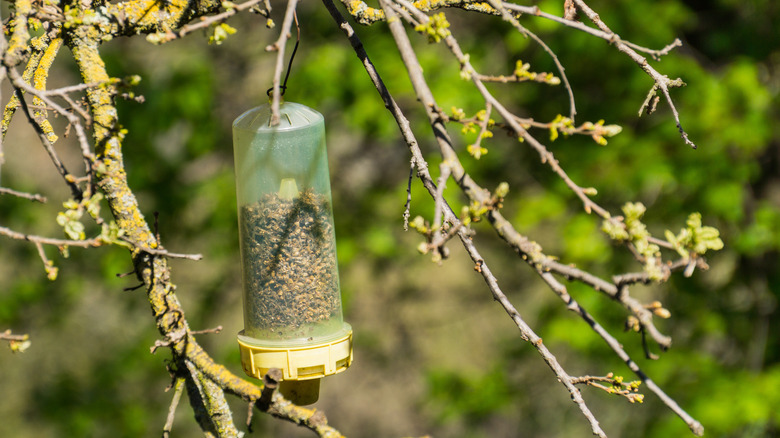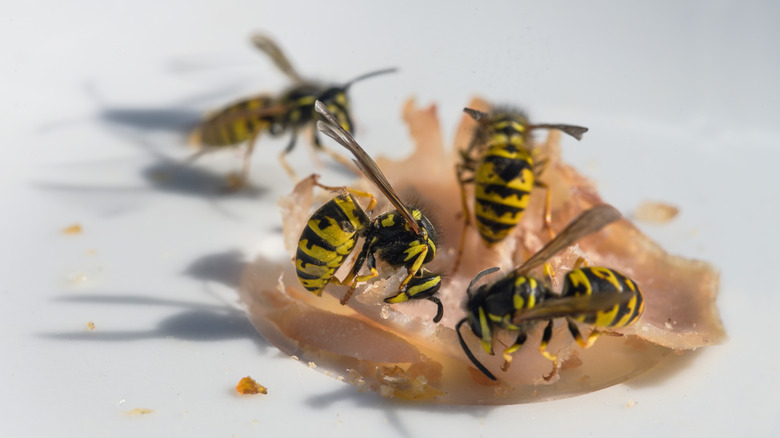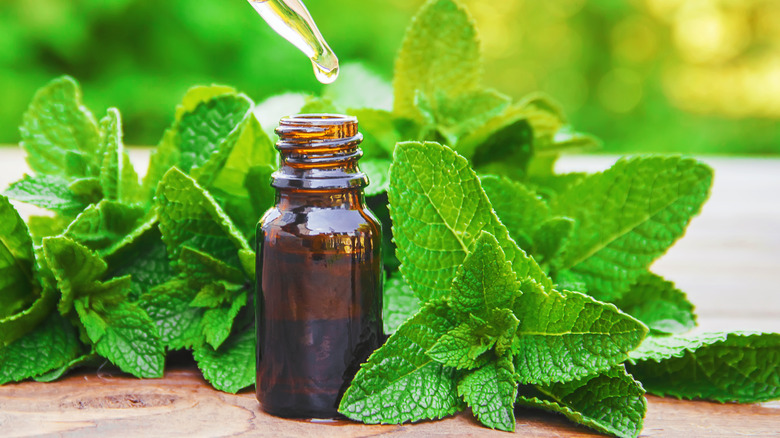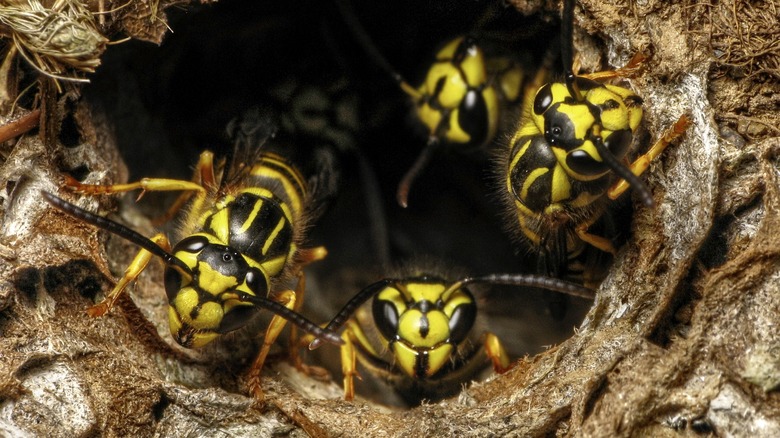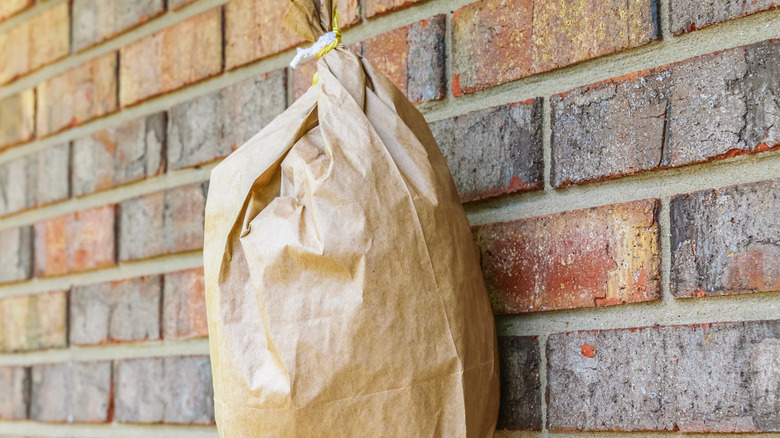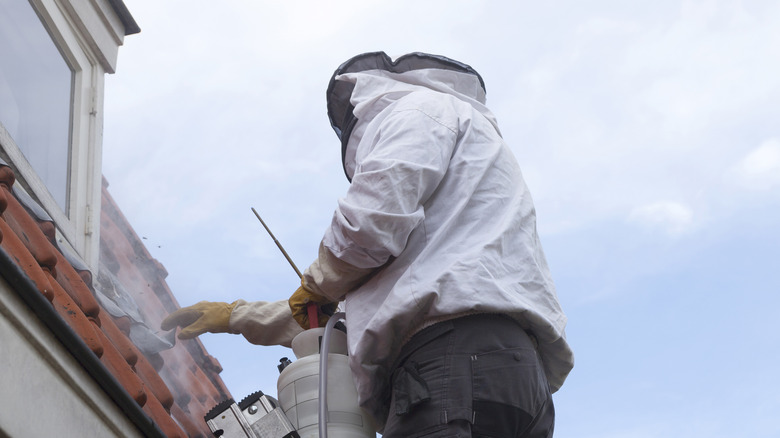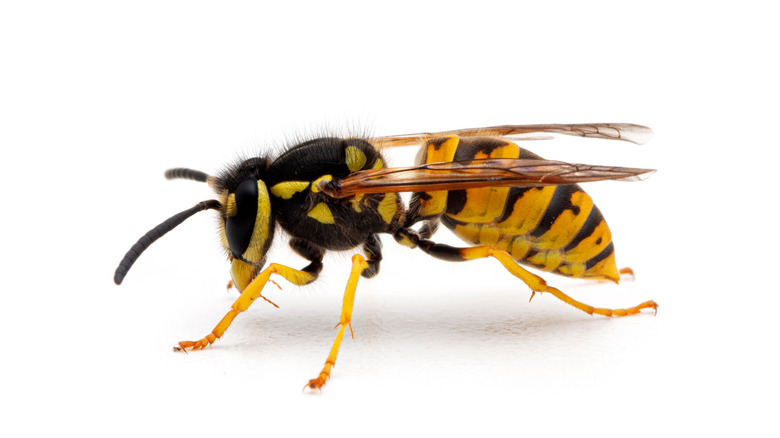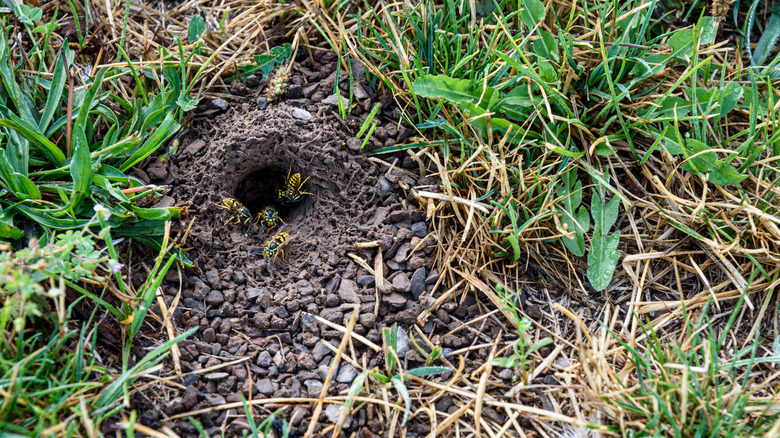9 Ways To Get Rid Of Yellowjackets
Yellowjackets are a type of wasp that love to crash a summer picnic. Unlike bees, yellowjackets are carnivorous, so once you break out the grill, they often come buzzing by to check out what's cooking. They also have a sweet tooth for flower nectar, and are attracted to fruit and sugary drinks. Though they look similar to bees, you can identify yellowjackets by the yellow and black markings along their abdomens with visibly segmented bodies connected by a very narrow "'waist,'" Pest World writes.
While it may be tempting to swat at the yellowjacket hanging over your hotdog, these wasps will attack when provoked, and can repeatedly jab you with their very large (and painful) stingers. And if you find yourself avoiding these insects in your yard often during warmer months, you may have a larger wasp problem to contend with, like a nearby nest. Here are a few ways to get rid of yellowjackets at home.
1. Make a DIY yellowjacket trap
If you don't suspect a nest is located on your property, trapping visiting yellowjackets is one way to keep them at bay. Tips Bulletin has several DIY trap ideas that will kill yellowjackets. For one, grab a 2-liter plastic bottle and add water, apple cider vinegar, and sugar. Mix thoroughly, then add a banana peel to the sugary liquid to attract the insects. Finally, cut a small hole for the yellowjacket to fly into and place the bottle in a secluded area. Another option involves mixing red wine with dish soap. These sweet baits will work better in late summer and early fall, the Northwest Center for Alternatives to Pesticides writes.
In early summer, protein bate traps will be especially effective. Fill a bucket with water and mix in dish soap, then hang a protein bate (like white canned chicken) a couple of inches above the water. The yellowjackets will fall into the water and drown. Be sure to keep the traps away from pets, and replace weekly.
2. Purchase yellowjacket traps
If constructing your own traps just isn't in the cards, there are plenty of commercial yellowjacket traps available for purchase. Kill The Wasps notes that traps are a reliable, pesticide-free way to eradicate yellowjackets, but they will not solve your yellowjacket problem if you have a nest (which can house an average of 2,000 insects).
Begin by choosing a trap that best suits your needs. Traps will typically hold 50 to 100 bugs, depending on the trap size and construction. Pest Control Hacks has a few favorites to consider; they recommend deciding between several factors. Do you want disposable or reusable traps? Are you looking for a trap that won't affect bees? And are you concerned if the traps use chemicals to lure yellowjackets? How easy are the traps to hang and handle? And do you have to provide the bait, or will it come with the trap? These questions can all be easily researched when buying traps and will help you find the best one for your needs.
3. Create a yellowjacket bait station
Another way to eradicate visiting yellowjackets is via a bait station. This involves lacing the insects' favorite foods with a chemical pesticide like Onslaught (per Kill the Wasps) and hanging it in a trap that they can easily access. Delayed-reaction pesticides will theoretically help bring down the nest if the yellowjacket returns home with the poisoned food. When using this method, it's important to practice caution. Keep the trap away from pets and children, and clean up any dead yellowjackets you find in your yard.
Without causing harm to the insects, you can also set up a food decoy when you are socializing with food outside. Simply place a plate of food they will find seasonally attractive (protein earlier in the summer, and fruits closer to autumn) at a safe distance away from your party, suggests Do It Yourself Pest Control. If you know the general direction yellowjackets fly in from, arrange the decoy so they will find it first (out of reach from kids and pets), at least 20 feet away from where you are eating. Think of it as your yellow jacket offering for a peaceful party.
4. Try yellowjacket repellent sprays
If you're only dealing with occasional visitors, try warding off yellowjackets with scents they dislike. Peppermint is very unattractive to them, Tips Bulletin notes, and you can make a simple solution using water, peppermint oil, and dish soap. Add it to a spray bottle and spritz any areas you think they might be attracted to, and hopefully it will keep them from staying too long.
You can also create a soapy spray that will stop yellowjackets from hovering nearby. Mix 1 tablespoon of dish soap with 1 cup of water and add it to a spray bottle. Shake, and keep it handy on your porch or wherever you're hanging out in the yard. If a yellowjacket won't stop pestering you, you can simply squirt it — the soap will coat its wings, making it unable to fly. But be wary when you pick a fight with an individual yellowjacket. Arrow Exterminating writes that once dead, a yellowjacket "gives off a pheromone which attracts more yellow jackets from its colony."
5. Remove yellowjacket nests
If yellowjackets are a constant problem in your outdoor area, then locating their nest to stop the queen from reproducing may be the only solution. But removing even a small to medium yellowjacket colony takes some advanced planning and skills. While it is possible to do this without an exterminator, one must use extreme caution. Additionally, those with allergies to yellowjacket stings should always avoid nests. It's recommended to only approach the nest after dusk, when yellowjackets have returned and are resting. Wear protective clothing, and be sure to have a clear path to an indoor space you can retreat to in case things go awry.
Home Depot recommends using a foaming aerosol spray, which can be sprayed into the entrance and will expand. Multiple applications may be needed. ABC Humane Wildlife writes that covering the entrance to a nest may not shut them in — in most cases, yellowjackets will simply create a new exit. They also note that simply spraying pesticides near the entrance of the nest won't do much since the insects must come in contact with the spray directly, and you'll most likely just anger the bugs and prime them to defend their home.
6. Create yellowjacket deterrents
There are several ways to make your home and yard less cozy for nesting yellowjackets. Bee Aware writes that growing plants that they find stinky, like lemongrass, peppermint, and thyme, helps repel them. To ensure your yard isn't attracting yellowjackets, make sure trash is managed efficiently outside and keep it well sealed, as noted by Home Depot. Otherwise, they will come foraging.
When yellowjackets are scouting for a new home in spring and early summer, hanging a paper nest (or using a paper bag) can scare away these territorial insects. The hum from electric bug zappers also tricks them into thinking they're being intruded when hung near a nest. Check your home exterior and yard to see if there's anything particularly welcoming to yellowjackets, like large cracks to burrow into, or overhangs and eaves that can be sprayed with repellants. Do It Yourself Pest Control notes that catching nests early, when they are still small, will make things easier to manage and can reduce damage to your property.
7. Utilize your county's local vector control services
Some counties have vector control services that will take care of issues like destroying yellowjacket nests, according to Kill the Wasps. Simply search for vector services in your county to see if one is available. The upside is that these services are typically free, and the professionals who come out will understand your local environment and the bugs that inhabit it best. You'll need to know where the nest is located and show it to them.
While having a yellowjacket nest on your property can be highly disruptive, most vector control services won't respond to nests in low traffic, uninhabited locations, so don't bother reporting a nest you saw on a hike in the woods. Yellowjackets play an important role in the ecosystem and balance out bug populations in ways that are beneficial to the environment, explains the Northwest Center for Alternatives to Pesticides — so as long as they're not bothering you, there is not need to bother them.
8. Call an exterminator
Dealing with a yellowjacket problem can be overwhelming. Not only will they aggressively defend their turf, once you've been stung, you can develop a sensitivity to them. According to University of Michigan Health, reactions can progressively become more intense with each subsequent sting. If you or anyone you live with are allergic to yellowjackets, removing a nest without help from pros is not recommended.
Luckily, exterminators are widely available and they have the tools to destroy yellowjacket nests safely. When choosing the right professional, ask the exterminator what materials or chemicals they plan to use, and what happens if the extraction isn't completely effective. Per the Northwest Center for Alternatives to Pesticides, aerial nests are typically detached and enclosed in a bag while other nests are vacuumed out. If you are having trouble locating the nest, the pros can help track down where the insects are hanging out. While exterminators are a bit pricier than DIY methods, there will be minimal risk of getting stung or having angry yellowjackets enter your home.
9. Smother the yellow jacket nest in the ground
Another option is simply smothering the yellowjacket nest right where it is in the ground. This traps the colony inside, keeping them from gaining access to food to survive. It also keeps any yellowjackets outside the nest from reentering, forcing them to relocate elsewhere. Plus, this method utilizes supplies you likely already have around the house.
First, you'll want to slow down the yellowjackets inside the nest. Pest Control Plus recommends using plain ice as a cheap and effective way to reduce the movement of the insects. Pour as many ice cubes that will fit into the nest, compacting it as fully as possible.
Then, work to cover the nest securely. You can use a thick plastic tarp, secure it with weights or stakes, and cover it with dirt. A sheet of plywood or MDF board can also adequately smother the nest. Or, if you'd like to monitor the progress, use a large glass bowl. Place it upside down over the hole, weigh it down to create a tight seal, and wait for the yellowjackets to die off (via WTOP).
